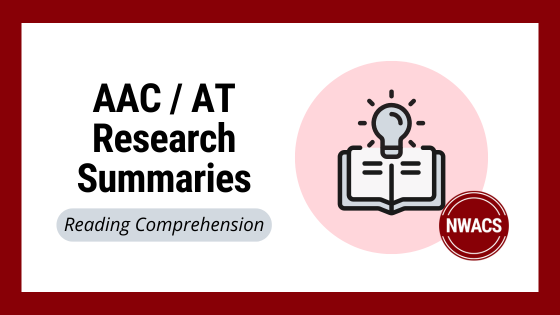by Grace Clark, PhD, SLP (speech-language pathologist); NWACS board member
reading time: 2 minutes
The views expressed in this post are those of the author and do not necessarily reflect the views and policies of NWACS. No endorsement by NWACS is implied regarding any device, manufacturer, resource, or strategy mentioned.
Research about Reading Comprehension
Did you know that about 1 in 4 autistic people need or use AAC (augmentative and alternative communication) to express themselves? SLPs and teachers often focus on building language and early literacy skills. But there’s one major area that we’re not talking about enough: reading comprehension.
Our lab (The ABLL Lab) looked at what research has been done to support reading comprehension in nonspeaking autistic children who use AAC. We searched five major research databases and reviewed over 500 articles. Only six met our criteria.
That’s right—just six studies looked at what nonspeaking autistic children understand when they read. So many of the studies we looked at focused on sounding out words or pointing to letters. Researchers never get to the heart of what we use reading for—to make meaning.
What did we find?
Researchers tested reading comprehension for AAC users in many different ways.
Every study used a different reading comprehension task. Many didn’t explain how well the children understood what they read.
Some children were asked to answer questions by speaking, which may not be possible for them.
Overall, the research wasn’t consistent or high quality.
Why This Is Important
We need better ways to check how well autistic children who need or use AAC understand what they read. This helps us teach reading in ways that work for them. These students deserve the same chance to grow as readers as other kids do. But to get there, we need research that:
Includes AAC users in meaningful ways
Uses tools and strategies that match how they communicate
Helps educators set clear, achievable goals for comprehension
What’s Next?
We need new and inclusive research that centers the thoughts and ideas of autistic children who use AAC. As SLPs, teachers, and advocates, we can push for better tools, better data, and better results.
Let’s go beyond teaching children to point to letters of the alphabet. Let’s make sure they also have the tools to understand, connect, and grow as readers in the ways that work best for them.
Want to read more? The full article (preprint) is available at: https://www.researchsquare.com/article/rs-7196396/latest


